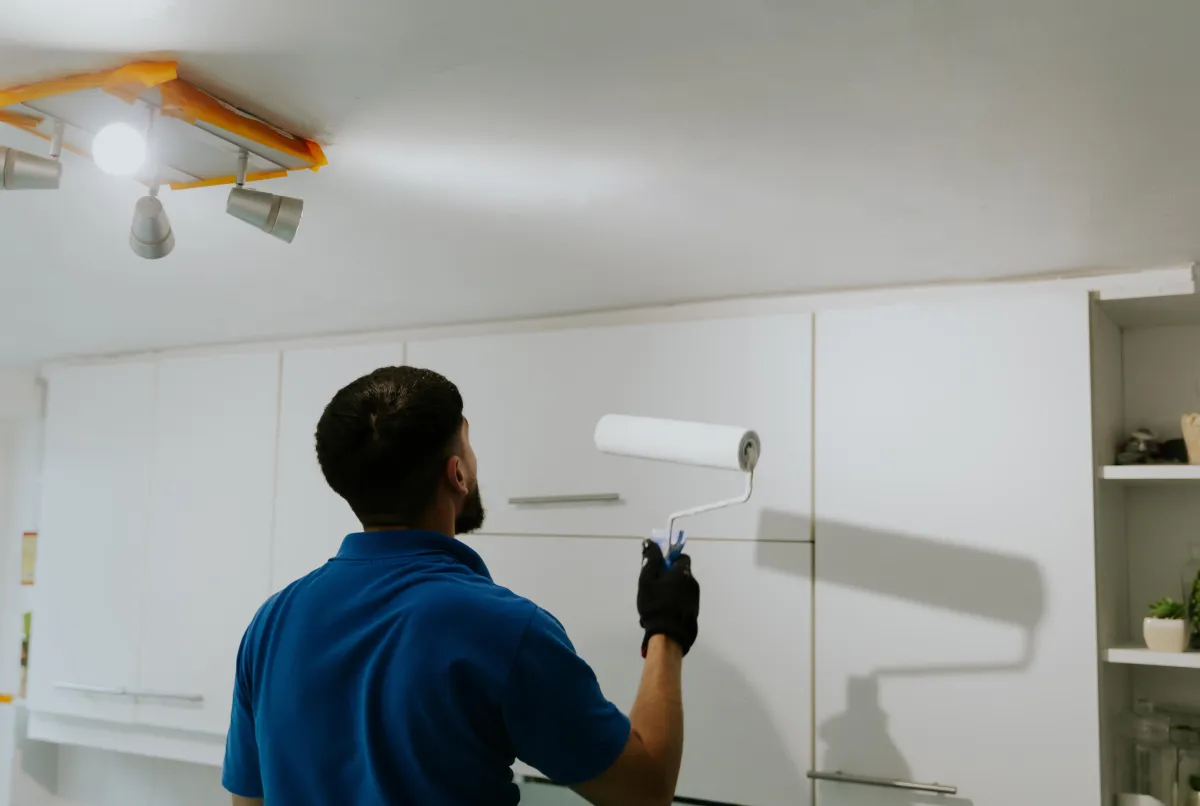
How much does it cost to repaint kitchen cabinets?
Repainting kitchen cabinets is one of the most transformative updates you can make to your home, offering dramatic visual change at a fraction of the cost of full replacement. While the immediate sticker price might seem high, this investment significantly increases the durability and aesthetic appeal of your most-used room.
Average Cost Breakdown
Professional cabinet painting costs are primarily driven by the time it takes to properly clean, sand, and prepare the surfaces—preparation often accounts for $70\%$ of the total job time.
Typical Range: $\$2,000–\$5,000$
For a standard-sized, mid-grade kitchen, the price range for a professional, spray-applied finish generally falls between $\$2,000$ and $\$5,000$.

Note: These estimates cover professional labor, high-end specialty primers, commercial-grade cabinet enamel, and all necessary protective masking.
Cost Per Linear Foot or Per Cabinet
Professionals typically use one of two metrics for bidding, with the per-cabinet (door/drawer count) method being the most precise.

What Affects the Final Price
The final quote is highly sensitive to the existing condition of the cabinets and the desired final result.
Cabinet Material, Size, and Condition
Material and Grain Filling: Wood species like oak or ash have deep, open grains. Achieving a smooth, near-factory finish on these requires a labor-intensive process called grain filling (using an epoxy or specialty filler). This step can add $\$500$ to $\$1,500$ to the total cost. Smoother woods like maple, birch, or MDF/Thermofoil bypass this expensive step.
Existing Finish: If the cabinets are heavily coated in decades of oil and grease (common near the stove), they require extensive chemical degreasing (using TSP or specialized cleaners). If the existing finish is peeling or severely damaged, it requires more aggressive sanding or stripping, increasing labor time.
Door Profile: Cabinets with intricate, detailed profiles (e.g., raised panel or ornate trim) take significantly longer to sand, clean, and spray than simple flat-panel (slab) or Shaker-style doors.
Number of Coats and Prep Work Required
Color Change: Switching from a dark color (like espresso or mahogany) to a very light color (like pure white) requires extra coats of high-hiding primer and at least three topcoats of paint to prevent the old color from showing through. This can add $15\%$ to $25\%$ to the quote.
Surface Prep (The Biggest Factor): Professional preparation includes removing, meticulously cleaning, scuff sanding, applying a specialized bonding primer, and sanding the primer smooth. This detailed, dust-controlled process is what separates a durable, long-lasting finish from a DIY job that peels within a year.
DIY vs. Professional Repainting
While a DIY approach saves money upfront, it demands a massive time commitment and often falls short on durability compared to a professional application.
Time, Quality, and Durability Comparison

Why Hiring Pros Often Pays Off Long-Term
The higher upfront cost of professional painting is an investment in longevity and finish quality.
Guaranteed Adhesion: Professionals use industrial degreasers and specialized primers (like shellac or two-part epoxies) that guarantee adhesion to the substrate, preventing the common failure of peeling paint.
Specialized Curing: Commercial paints require specific drying times and conditions, often taking up to 30 days to reach full cure. Professionals use paints that are designed for this high-traffic use and apply them correctly to achieve maximum hardness.
No Home Disruption: Doors and drawer fronts are typically removed and taken to a controlled shop environment for spraying, minimizing the mess and odor in your home.
Ways to Save Money
If the professional quote is stretching your budget, there are several ways to intelligently reduce the final cost without sacrificing the quality of the finish.
Keep Hardware and Repaint the Same Color
Reusing Handles and Pulls: New hardware costs can range from $\$5$ to $\$30$ per piece. Reusing your existing $30$ pieces can save you a minimum of $\$150$ to $\$900$.
Minimal Color Change: Sticking close to the existing color (e.g., cream white to pure white) reduces the number of paint coats needed, thereby reducing the labor time and material consumption, which is the easiest way to trim the cost.
Combine Kitchen and Trim Painting Projects
Many professional painters offer discounted rates when bundling work.
Package Deals: Ask the painting contractor for a bundled price that includes the cabinets plus interior doors, kitchen trim, or crown molding. By maximizing the work done during one mobilization, you can often negotiate $5\%$ to $10\%$ off the total combined price.
DIY Prep Work: Some professionals will allow you to handle the tedious initial labor, such as removing the doors, taking off all the hardware, and masking large areas (like the floors or countertops), provided you follow their specific instructions. This can reduce the labor hours they need to bill.
FAQs
How long does cabinet repainting take?
A professional cabinet repainting job typically takes between $3$ to $7$ days.
Day 1: Removal, cleaning, and light sanding/prep on-site; the team transports the doors/drawers to the shop.
Days 2-5: Primer, sanding, and $2\text{-}3$ coats of topcoat applied in the shop (allowing for proper flash and cure times).
Day 6-7: Final coat applied to the fixed cabinet boxes on-site; reinstallation of the fully cured doors, drawers, and hardware.
Is repainting cheaper than refacing?
Yes, repainting is significantly cheaper.
Repainting (New Color on Old Doors): Focuses solely on the finish. Cost is typically $\$2,000\text{-}\$5,000$.
Refacing (New Doors on Old Boxes): Involves replacing all the old doors and drawer fronts with new ones (often in a new style, like Shaker) and applying a new veneer to the cabinet boxes. Cost is typically $\$7,000\text{-}\$15,000$.
You should choose refacing only if your current door style is outdated, or the doors themselves are physically damaged or warped. If you like your current door profile, repainting is the clear cost-saving champion.
Don't let the thought of a renovation budget delay your dream kitchen. Repainting offers the best return on investment for visual impact.
Ready to find out the exact cost for your kitchen? Contact Masterpiece Painter today for a detailed, no-obligation quote and start your kitchen transformation!